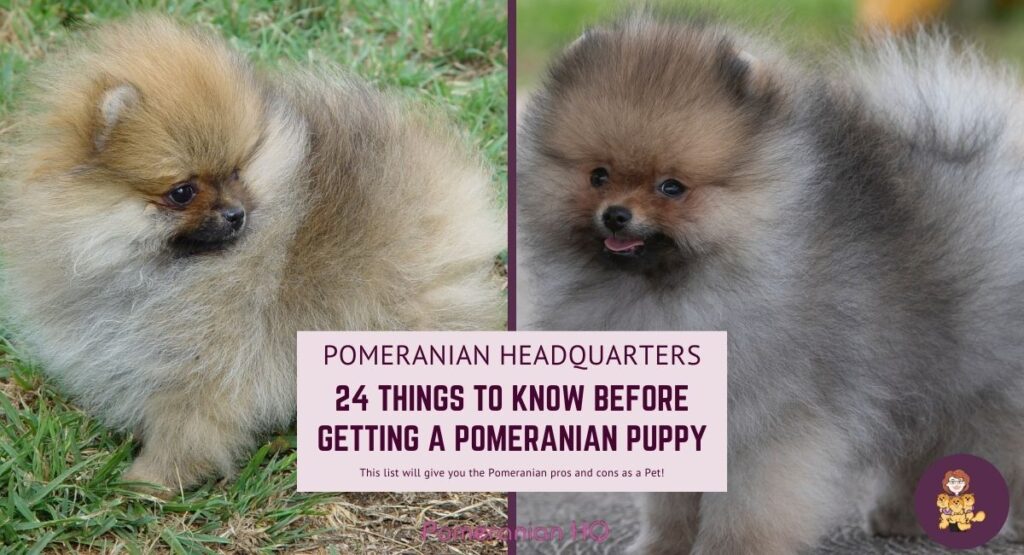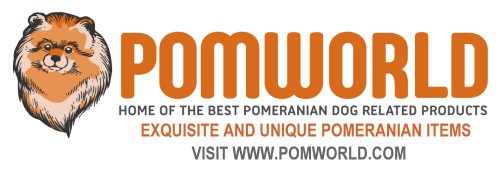Last Updated on 26/04/2024 by Denise Leo. Post first published on April 26, 2024.
With their distinctive fox-like faces and luxuriously thick coats, Pomeranians embody the allure and complexities of sharing your life with a small dog breed. As one of the most sought-after toy breeds, these pint-sized canines are renowned for their lively temperament and endearing appearance, making them a beloved choice for dog enthusiasts, even in compact living spaces. Despite their diminutive stature, Pomeranians are a bundle of energy requiring meticulous care to flourish.
For those considering adopting a Pomeranian, whether a male or female, puppy or older dog, it’s essential to understand both the joys and the commitments associated with these fluffy companions. There’s much to consider, from their status as a top breed registered with the American Kennel Club to their specific needs, such as regular exercise and grooming.
Pomeranians can be a good idea for novice dog owners and experienced dog lovers alike, provided they are ready to handle their exercise needs, grooming requirements, and heat cycles in the case of female Pomeranians. Understanding and being prepared for these responsibilities is key to a successful Pomeranian ownership.
This guide explores the advantages and challenges of owning a Pomeranian, offering insights into what it truly means to live with these energetic, long-coated companions. Whether you’re looking to rescue a Pomeranian from an animal shelter or purchase one from a reputable breeder, understanding these details will help you and your tiny companion enjoy a happy, healthy life together and make you a confident and knowledgeable Pomeranian owner.
A Pomeranian is naturally man’s best friend, but he’s also fiercely loyal, smart, cuddly, and incredibly adorable. Here are full details of the Pomeranian’s pros and cons. The Pomeranian’s intelligence level is high, and they are adventurous little dogs with a “Napoleon complex.”
I have several Pomeranians, and I would never give them up or the amazing experiences I have shared with them for anything.
A Pomeranian is an ideal pet because of several traits that, once combined, create your family’s perfect 4-legged furry member. The characteristics may be temperamental and physical.
The key is to learn what you’re facing if you get a Pomeranian. You may already own one or two Poms, but it doesn’t guarantee that you’ll already know about all the traits these amazing creatures can offer you and your family.
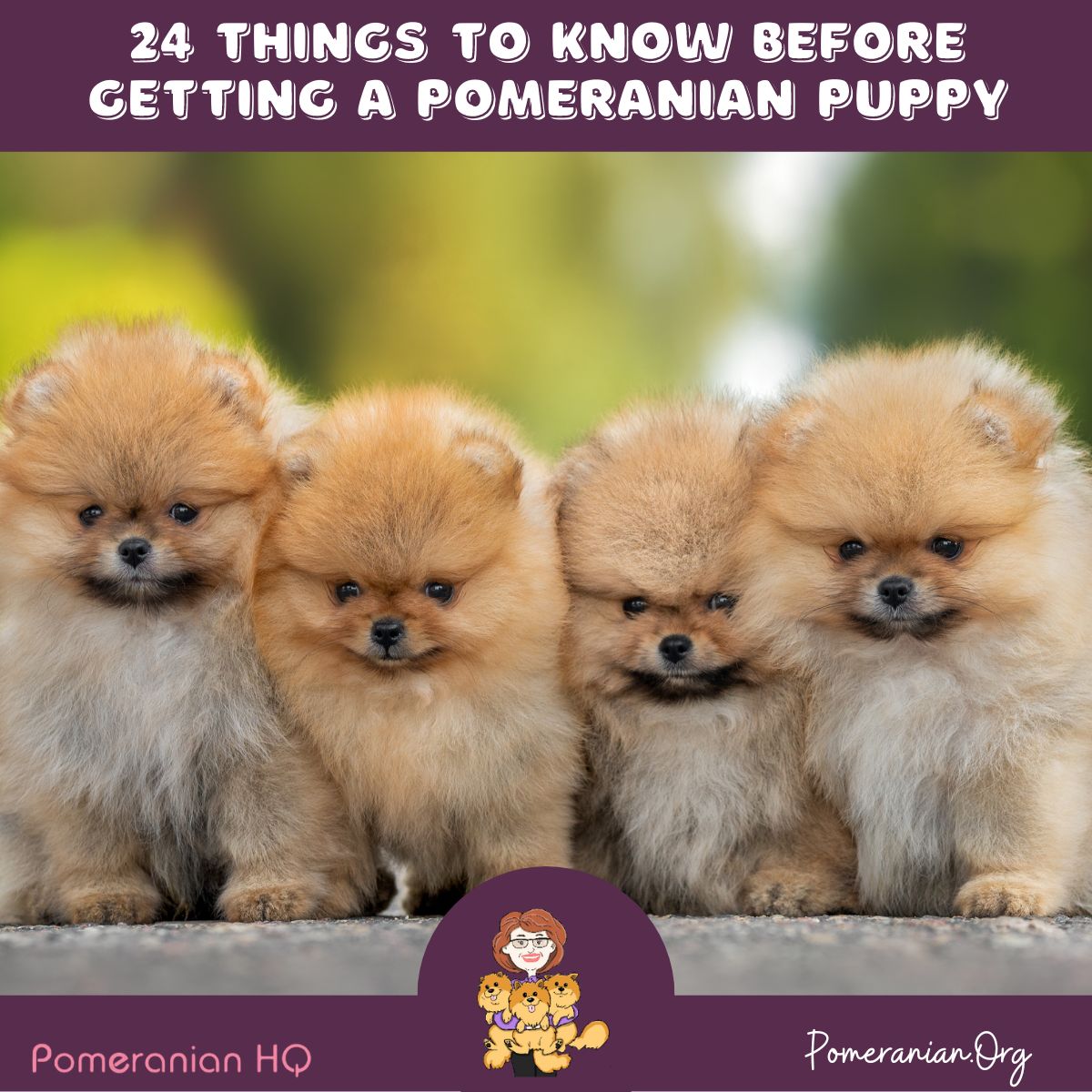
Pros and Cons of a Pomeranian as a Pet
1. Pomeranian Intelligence Level is High
They thrive on challenges and do well in many dog sports. They need training, or they’ll train their owner. All dog breeds have their own learning styles, and Pomeranians love to be taught new tricks and pick things up quickly.
Despite their diminutive size (which they don’t realize), Pomeranians often confront other much bigger dogs – but they’ll still refuse to back down.
Poms are active, playful, extremely friendly, and fiercely protective of their owners.
2. Pomeranians are Adventurous
Pomeranian energy level is high, and they are extremely adventurous animals. As for an attribute you wouldn’t expect from a toy dog, they make exceptional watchdogs. If they can hear or see something wrong in your house, their loud bark will quickly have you running.
If someone rings the doorbell or knocks, the barking will alert you, whether it’s someone you know or a stranger. There go all the store fundraising door knockers.
Unless a Pom barks, it’s a great deterrent unless he can be seen. If it’s a stranger and he’s seen, it may or may not be enough to scare them off.
3. Pomeranian Grooming Needs
Many owners of other dogs seem to be jealous of a Pom’s glorious, puffy coat. Pomeranians have large coats that protect them from the weather and keep them warm. However, a large coat means you need to care for it properly.
A Pomeranian has two coats – an inner coat and an outer coat. The inner coat (aka base coat) is dense, letting him stay warm in colder weather and somewhat toasty during Summer.
His outer coat is much lighter, and it protects the inner coat from most weather conditions. To maintain a healthy coat, he should be brushed daily with a good-quality brush. Your Pomeranian would love that feeling and the attention he’s getting.
Keeping your Pomeranian’s coat as healthy and clean as possible is necessary. It’s especially critical if the inner coat has been damaged in any way because there’s only a low possibility of regrowth.
Ensure that only a trained professional cuts your Pom’s hair and that they don’t cut the inner coat in any way.
Make sure that when anyone cuts your Pomeranian’s hair, they are trained professionals who know not to cut into his inner coat.
4. Pomeranian Barking
Some people love talking a lot, and some cats love “meowing” a lot, and, of course, there are dogs that enjoy barking. Pomeranians certainly fit the “barking” category, and it can be funny at times but can be irritating during the bad times.
When they’re full of energy, their behavior demands lots of attention from everyone around them, making it impossible to ignore.
Pomeranians are naturally very boisterous, which is evident because they bark a lot. However, there are other reasons for them to be classified as big barkers: they’re extremely loyal and fiercely protective of their owners. There will sometimes be a reason for their barking.
For example, if they’re barking at squirrels, cats, or people walking past your home (with or without a dog), and sometimes they’ll bark at you if they become too excited.
In my experience, they’ll often do it to warn you, thereby keeping you safe. They want the absolute best for their human parents.
5. The Pomeranian Napoleon Complex
Have you ever noticed your Pomeranian walking around expecting everybody (human and animal alike), to pay full attention to him immediately?
It can feel like he’s a member of royalty, and I suspect he uses that to his benefit. He might be quarreling with a larger dog, but he’ll refuse to concede.
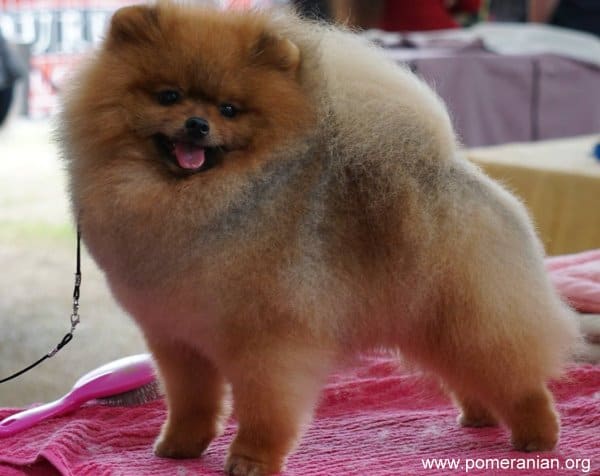
Pomeranians certainly possess a “Napoleon complex,” like numerous other small breeds. They were members of royalty in days gone by. Queen Victoria was a major contributor to creating today’s modern Pomeranian.
Whether this is or isn’t, why a Pom pretends he’s a big dog in a small body, it’s certainly a Pomeranian’s very cute trait.
6. Easy to Stay Healthy
One aspect of a pet’s care is ensuring he can burn off energy accumulated and stored during his numerous naps daily. It’s also necessary that he has enough exercise daily.
This can entail running around the house, walking, playing fetch in the garden, and more options. This is vital to your Pomeranian’s life, particularly if he should lose weight.
Because a Pomeranian is small, he won’t have a lot of calories to burn. He won’t consume much food compared to the larger breeds, so a short walk every day is ideal.
Providing the walk is down the street or around the court, a Pomeranian’s compact body will find plenty of regular exercise.
7. The Pomeranian and Kids
Pomeranians are not 100% kid friendly. It’s common for families to want a dog at least once, and at first glance, a Pomeranian would be perfect. Being small, a Pom seems ideal as he’s similar to a small child. It appears that there would be a lot of fun involved.
However, the truth is a bit different. Because of their size, a Pomeranian can be hurt easily if he’s playing with one or more small children.
Children of that size are still adjusting to how strong they are because they keep growing, and the Pom might be hurt if playing gets a bit rough. Pomeranians are also proud creatures; the dog may lash out if a negative interaction occurs.
If you want a Pomeranian because you have children, wait until they’re a minimum of ten years old. If you have a child under ten and a Pomeranian, ensure you never leave them together unsupervised, or an accident may happen.
8. Are Pomeranians Loyal?
It’s a well-known fact that dogs are man’s best friend. One major reason is that, when it comes to humans, dogs are the most loyal creatures in the world. Pomeranians certainly match this description, and their unique character is extremely obvious.
When you get home from your job, your Pomeranian may run and greet you, tail wagging, and then he’ll spin in circles of joy. He might bark if somebody rings the doorbell to warn you of possible danger.
Eventually, you’ll end up on his good side after some time, and his loyalty to you will last forever. He’ll attempt to make sure you’re safe and strive to protect you whenever the chance arises.
It’s somewhat ironic that your small Pomeranian needs to protect you, considering his size, but it’s deeply embedded in his genes.
9. Pomeranian Separation Anxiety
Dogs have so much love for their owners that if you’re even away from home for two hours, it feels like their whole world has collapsed.
Pomeranians have a well-earned reputation for becoming super-glued to the person who owns and loves them in return, which is just one reason why Pomeranians are extremely popular. If you love your Pom, you’ll be given 10-fold love in return.
However, this is where separation anxiety can occur each time you leave your Pomeranian, even if it’s with other people that your dog knows and feels safe with.
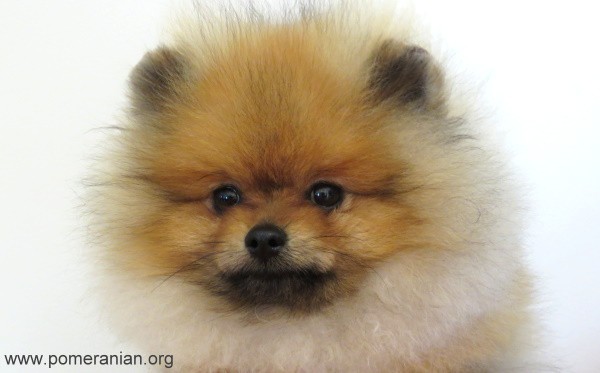
Behavior can vary from one dog to the next and may include feelings of sadness, crying, and waiting next to the front door from the moment you leave until the exciting minute you return.
At first, this seems to be a cute trait because it’s a demonstration of how much your Pomeranian loves you and, at the same time, hates you being absent. Pomeranian separation anxiety isn’t healthy, and you should find an experienced dog trainer to help reduce the problem for you.
10. Pomeranian Spinning
One of the strong characteristics of a Pomeranian is that he’ll spin in circles non-stop and at a great speed every time he becomes extremely excited. It can cause you to feel dizzy if you watch it.
For an example of Pomeranian spinning, if you come home and say “walk” or touch his leash, he’ll begin to spin and bark excitedly simultaneously. Imagine those actions when you own a few Pomeranians; it will feel like chaos.
Other dog breeds also behave this way each time they become excited, but owners of Pomeranians know that it’s typical everyday behavior. All your dog is showing you is that he’s ecstatic and happy about whatever is next. I always say this is the Pomeranian saying: “When you are happy and know it…have a spin!”
11. Black Skin Disease Pomeranian
Several medical problems are commonly found in Pomeranians, many resulting from genetics. However, the saddest disease that a Pomeranian can experience (with few exceptions) is Black Skin Disease (also known as Alopecia X).
This disease can strike several spitz breeds, including Poms, and it can cause permanent hair loss and skin discoloration. It’s particularly insidious in that it strikes without warning.
If your Pomeranian’s hair begins to fall out and his skin color changes to dark gray and then black, you need to talk to your breeder and Vet about possible ways to control the issue.
12. Luxating Patella Pomeranian Issues
There are a few health issues all Pomeranian parents should know. The number one problem that Pomeranians experience is the luxating patella, i.e., when their kneecap moves in and out of its socket.
Unfortunately, this problem often results from environmental issues or can be genetically damaged. Keeping your Pomeranian trim and healthy, feeding a correct diet, and banning your Pom puppy from jumping up and down from furniture can help prevent this issue.
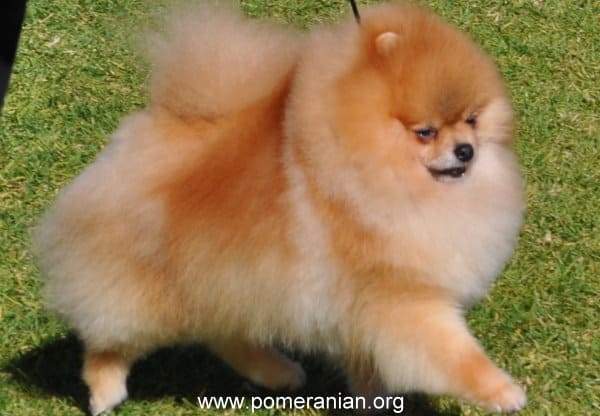
It can also be in their genes, so you must be mindful. If your Pom is walking differently from his usual way due to his back leg(s) not bending, he most likely has a luxating patella.
However, there’s positive news. Knee surgery can fix the problem fairly easily, so speak to your vet about it.
13. Pomeranian Collapsed Trachea
A Pomeranian trachea collapses when the cartilage surrounding your Pom’s windpipe breaks down, forcing it to collapse, blocking his normal airflow. Such a collapse is frightening for both the owner and the Pomeranian concerned.
If his trachea collapses, several different procedures can be carried out. However, Pomeranian collapsed trachea surgery is usually the most expensive.
Owning one Pomeranian can be costly over the years. There is another, cheaper, and probably not an as efficient choice if your Pomeranian’s trachea has collapsed.
It’s why the majority of Pom parents choose a particular dog cough medicine formulated for canines whose tracheas have collapsed.
Collapsed Trachea in Pomeranians Remedy
PawHealer Trachea Support Phlegm Heat Pattern Herbal Cough Powder, 100g
Pomeranian Collapsed Trachea Symptoms
If your Pomeranian exhibits any of the following symptoms:
- Heavy breathing after a period of activity.
- Gagging/choking after having a bite to eat or a drink.
- Pomeranian collapsed trachea cough sounds more like a very loud goose honking.
The diagnosis might be a Pomeranian collapsed trachea.
If this occurs, you must urgently take your furry family member to the vet, ringing beforehand so he’s expecting you and has a vacant table. Then, you can discuss potential Pomeranian collapsed trachea treatment options.
14. Pomeranian Food Allergies
Today’s dog food products contain many chemicals, preservatives, and additives, and when you try to read the labels, many of the ingredients are either unpronounceable or in a foreign language.
The major branding companies generally don’t include organic or all-natural ingredients because it affects their bottom line. Instead, they opt for as many shortcuts as possible to guarantee their costs remain as low as possible while still making loads of sales and maximizing profits.
Pomeranians and their counterparts in the small breed categories are extremely susceptible to many of these chemicals, preservatives, and additives and frequently trigger allergic reactions. Corn, wheat, and various meats can also cause Poms allergies.
The smartest way to deal with such problems is to closely monitor each product you feed your Pomeranian and make a precise list of problem foods. Then, avoid those ingredients and focus your spending on completely natural, top-quality food for your much-loved ball of fur.
15. Pomeranian Bad Teeth
I’ve heard it said that dogs are high on the list of living creatures with the cleanest mouths on the planet, often cleaner than people’s mouths.
Sadly, Pomeranians aren’t at the top of the dog category because they have difficulty keeping their teeth as clean as they should be, leading to bad cases of breath that are downright stinky.
Pomeranians are recognized as having bad teeth, but the good news is that numerous cleaning options work for proud owners. This means I must brush their teeth (it is extremely time-consuming if you own more than one Pomeranian).
However, I continue to use a toothbrush and toothpaste to brush their teeth every two weeks. Initially, I was doing that big job every week, but it felt rather excessive because I own quite a few Pomeranians, and each one needs the same love, care, and attention.
I use the following additives in their food daily:
- FRESH PET BREATH – Finally say good-bye to dog and cat bad breath with our fast-acting pet bad breath treatment for dogs and cats. It’s the best, quick & easy cat & dog breath freshener.
- CLEAN TEETH AND GUMS – The easiest way to clean your pet’s teeth! Our veterinarian recommended cat and dog oral care water additive helps fight plaque and tartar for healthy teeth and gums.
- SKIP THE BRUSHING – That’s right, no more wrestling with pet toothpaste and toothbrushes; just add a capful of our cat and dog dental care liquid to their water bowl each day – it’s that easy!
- PICKY PET APPROVED – We don’t mask with mint or tea tree that can be harmful to dogs and cats. Our Pet Dental Water Additive is odorless and tasteless, so they don’t even know it’s there.
- IT WORKS – Trusted by pet parents, our cat and dog dental water additive is made in the U.S.A. with only the highest quality ingredients, and is a pet bad breath eliminator that actually works.
16. Is The Pomeranian Temperament Extroverted?
Everybody understands the personality differences between extroverts and introverts. Pomeranians would appear high on the list of extroverted animals you’re lucky to find. They’re great at commanding any audience and thrive when they’re the center of attention.
Your Pomeranian has a few ways to attract attention, including begging, barking, spinning around in circles at speed, or simply getting in the center of the action. Don’t expect your Pomeranian to stop this behavior.
Earlier, I mentioned how Pomeranians are extremely loyal and adore barking, whatever the reason – but these are merely part of being an extrovert.
Despite being cute and charismatic, never let a Pom manipulate you into giving them what they want (E.g., human food or treats). A Pomeranian, regardless of what he does, can be very convincing when he wants to be.
17. Pomeranian Potty Training Troubles Are Common
You might live in an apartment building, on a farm, in a house, or somewhere completely different. However, there’s one common denominator: your Pomeranian will need to learn what suits his surroundings, and that’s potty training. Pomeranians aren’t exempt from this but appear harder to train than most dogs.
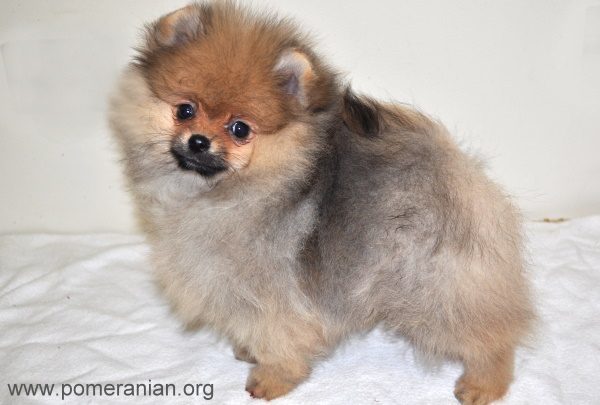
I have no idea why, but they have trouble learning not to do their business in the home. Some other canines I own (non-Pomeranians) usually learn this faster than my Poms.
Perhaps it’s psychological, and I am letting them get away with more than I should just because they’re so adorable. I sure hope this is NOT true.
18. Pomeranian Dog Lifespan
When you look at how long small dog breeds live, you’ll see that the lifespan for a Pomeranian is longer than most others. A Pomeranian can live between 12 – 16 years.
The figures I have mentioned are estimations because Pomeranians can lose their lives when they’re younger or older. If you do everything possible to look after your Pomeranian, including sufficient exercise, plenty of rest, high-quality food, plenty of love, and TLC each day, then living a long, healthy life should be something for him to look forward to doing.
19. There Are Many Different Colors of Pomeranian Dogs
Of all the dogs, breeds, sizes, and shapes that live in this wonderful world, the energetic Pomeranian breed of dogs comes in the most incredible array of colors in the same world.
Different colors of Pomeranians may include red, orange, black, sable, cream, white, merle, chocolate, brindle, etc. Orange, sable, and cream are the most popular colors, and the rest appear less frequently.
When Pom puppies first come out to join their families, they’re often lighter in color or darker than they’ll be upon maturity. All Pomeranians I have ever enjoyed owning were one of these colors, except Merle and Brindle Pomeranians.
20. How Much Do Purebred Pomeranians Cost?
Owning any dog won’t be a cheap prospect in the long term because after you pay for the rights to own him, you’ll need to feed him, give him toys to have fun with, take him to the local vet, and get involved with other members of your existing family, regardless of the number of legs. And so the list goes on and on.
Pomeranians are very popular dogs, and their purchase price will reflect that. If you want a Pom puppy, you’ll need to spend $2000 – $5000; the average cost will be $3500.
However, if money is an issue, consider an older Pomeranian or perhaps one currently in a rescue shelter. The price will plummet. If you want a purebred Pomeranian with exotic colors, your starting point is many thousands of dollars.
21. Pomeranian Portability
In today’s modern world, life is quite portable; some people think dogs should also have some portability. Pomeranians are much smaller than most other dogs, so it’s much simpler to put yours in a specially designed backpack for dogs, and off you go.
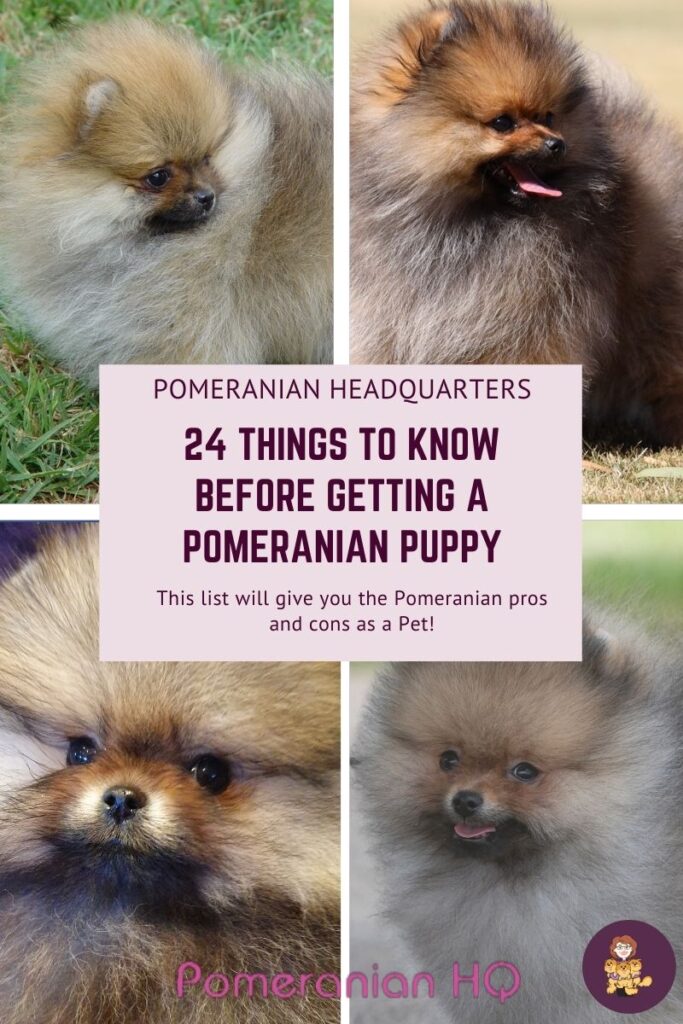
Some owners take mobility to an even more comfortable level and strap him into his dog stroller. They’re among the cutest dog products, and I’m certain my own Pomeranians would love to sit in a stroller when they’re tired after their walk. It would also be terrific if I wanted to take them when I go for runs.
22. Pomeranian Size Has Drawbacks
They can easily hurt themselves when jumping off furniture, getting stepped on, or being dropped. They’re small enough to make you trip if they get in your way.
23. Pomeranian Size Advantages
- It costs less to care for smaller dogs in general.
- Their food bill is considerably smaller than that of a bigger dog.
- They don’t eat a lot, so their toilet deposits are smaller.
24. From the Land of Pomerania
Today’s Pomeranians have descended from a very long, proud line of ancestral dogs that themselves had descended from wolves. While people describe Poms today as cuddly and cute, that hasn’t always been the case. Pomeranians have an ancestral line of Arctic working dogs from a region known as Pomerania (located in Germany and Poland).
The original Wolf Spitz dogs were strong, working dogs of good character. They were loyal to their master, whom they fiercely protected while getting their job done.
All these characteristics remained when Pomeranians were bred down to the smaller cuddy, a cute variety we see today. Most of today’s Pomeranians possess qualities that come from their proud ancestors.
The Conclusion is To Get Yourself a Pomeranian
In conclusion, with their fox-like faces and fluffy double coats, Pomeranians are adorable companions that fit well in various environments, from small apartments to larger homes. Despite their small size, Pomeranians are energetic dogs that bring high energy and unconditional love to their owners.
Prospective and current Pomeranian owners should know the breed’s needs, including regular brushing to maintain their long coats and proper training to manage excessive barking.
While they are great for families, the presence of young children requires constant supervision to prevent rough play, which might be too intense for these small pups. Additionally, those living in close quarters, such as apartment complexes, should consider a Pomeranian’s potential for excessive barking, which might disturb close neighbors.
On the health front, conditions like skin conditions, patella luxation, and the need for regular professional grooming require attention.
Adopting a Pomeranian from rescue organizations or through reputable breeders ensures that you provide a loving home to a dog in need or support ethical breeding practices. For first-time dog owners, understanding the characteristics and needs of this toy breed and a commitment to providing good care, including positive reinforcement and proper training, can make owning a Pomeranian a delightful experience filled with fluffy affection and lively companionship.
Copyright Pomeranian.Org. All Rights Reserved.
References and Further Reading:
[1] Official Standard of the Pomeranian (AKC). American Kennel Club, 2011.
[2] Official English Kennel Club Pomeranian Breed Standard, 2017.
[3] Kimbering Pomeranians “1891-1991”.
[4] Denise Leo, The Pomeranian Handbook.


